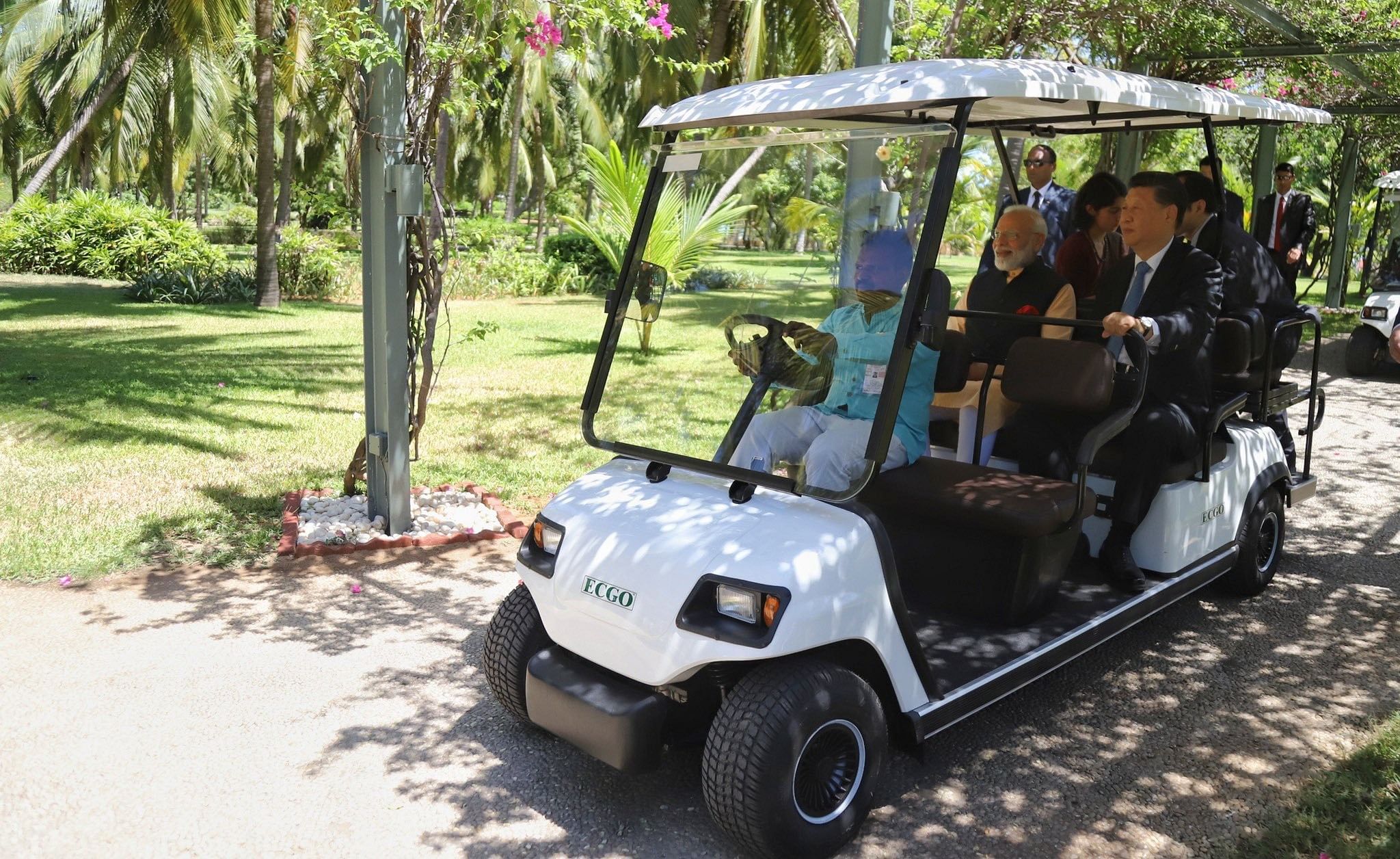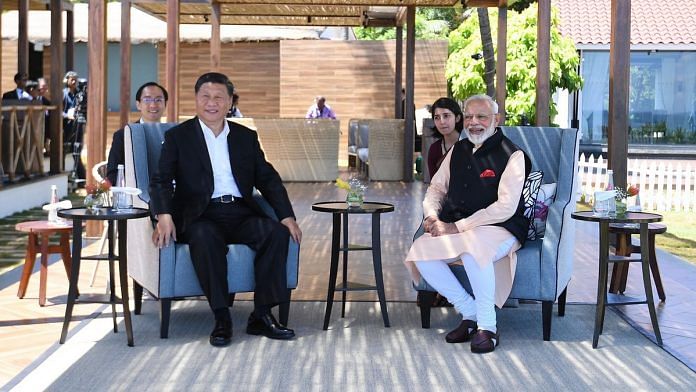New Delhi: As Prime Minister Narendra Modi and Chinese President Xi Jinping sought to paint a picture of intimate engagement at their informal summit in Mamallapuram this month, away from all other government representatives, they were not alone.
Dressed in crisp formals, two officers of the Indian Foreign Service (IFS) were seen shadowing Modi and Xi, leaders of two of the world’s largest economies, as they walked about the resort town.
R. Madhu Sudan, looking dapper in a suit and red tie, and Priyanka Sohoni, graceful in a plum saree, were not just listening in on the conversation, they were helping conduct it (as were their Chinese counterparts).
Interpreters have been key to the diplomacy machinery since the days of yore, but their role takes on new meaning under a PM looking to forge personal chemistry with world leaders via informal interactions as a stepping stone to healthier bilateral ties.
By virtue of their role, they are privy to confidential discussions that some of the leaders’ closest aides may not know about.
Add to this the fact that the primacy enjoyed by the US and Russia until the 1990s has given way to a multipolar world order where English alone is not enough to get by.
PM Modi himself has shown a preference to talk in Hindi, which has made quick, accurate interpretations almost a prerequisite for smooth equations — any slip-up could mean embarrassment or, worse, a communication gap nations can ill afford.
While the Ministry of External Affairs (MEA) has a dedicated interpreters cadre, an urgent need for more language experts has led the government to start training IFS officers in at least four foreign tongues.
Amarendra Khatua, former Indian ambassador and secretary in the MEA, said interpreters are also often professors from institutes such as Jawaharlal Nehru University (JNU), Delhi University (DU) or Jamia Milia Islamia. At times, freelancers are called in on the personal invitation of prime ministers, Khatua added.
Sources said some interpreters also come from California State University, Monterey Bay. The languages spoken vary from Mandarin to Spanish, Japanese, German and Arabic.
Khatua added that interpreters were rated by a large panel on three accounts — fluency, accuracy and simultaneous translation. When asked why interpreters largely stayed away from the media glare, Khatua said “names of the interpreters are not given out because then their role becomes limited”.
Apart from Madhusudan and Sohoni, Modi has been aided in his diplomacy overtures by a dynamic bunch of diplomats. ThePrint lists out a few spotted during Modi’s recent interactions with world leaders, from Xi to Putin.
Also Read: How interpreters can make or break it for leaders like Narendra Modi
R. Madhu Sudan and Priyanka Sohoni
Madhu Sudan, an officer of the 2007 batch, and Sohoni, of the 2012 batch, are both fluent in Mandarin.
Sohoni, who is posted in the Indian Embassy in Beijing, had won the external affairs minister’s gold medal for best officer trainee in her batch.

Madhu Sudan, an engineer from Anna University, Chennai, had also accompanied PM Modi for the first informal summit in Wuhan.
Currently, he is serving at the Ministry of External Affairs in Delhi as deputy secretary. His first posting was at the Indian mission in Beijing, where his brush with Mandarin began.
He is fluent in three languages — Mandarin, Tamil, English — and well-versed in another two, Hindi and Malayalam.
Shilpak Ambule of the 2002 batch served as the PM’s Chinese interpreter before S. Madhusudan. He is also regarded highly by External Affairs Minister S. Jaishankar.
Others in the ranks include Vipin Kumar, an IFS officer of the 2013 batch who is PM Modi’s Russian interpreter. Kumar has been a fixture at PM Modi’s engagements with Russian President Vladimir Putin, including at their May 2018 informal summit in Sochi.

The Maulana Azad Medical College alum is posted in the Indian Embassy at Moscow, and often tweets in Russian.
Suman Kansotiya of the 2012 batch serves in the Indian embassy in Japan. She finished her Japanese course recently and hasn’t had the opportunity to interpret for the PM yet.
Nilakshi Saha Sinha
Primarily a French interpreter, Nilakshi Saha Sinha has been shadowing Modi on most of his trips abroad, translating between Hindi and English. She is reportedly one of Modi’s trusted interpreters.
Currently, she serves as director in the West Asia and North Africa division of the MEA, and is well-versed in Hindi, English, Bengali and French.
Sinha found herself in media glare last year when her English translation went on longer than Modi’s answer during an interview at Nanyang Technological University in Singapore, leading to suggestions that the interaction was scripted in advance.
The first Indian PM who takes "spontaneous" questions that the translator has pre-scripted answers to!
Good that he doesn't take real questions. Would have been a real embarrassment to us all if he did. pic.twitter.com/8Iyfgiaseh
— Rahul Gandhi (@RahulGandhi) June 4, 2018
Gurdeep Chawla
Chawla has been an interpreter for 29 years, having started her career in Parliament at the age of 21. Chawla, a US citizen, is a familiar face since she has often been seen in photos of PM Modi, as well as President Ram Nath Kovind, with other world leaders.
In an interview to The Economic Times, she explained the challenges of the job thus: “You can’t take a break. You are in the moment listening, analysing and translating. You have to bring out the colour, tone and message out perfectly. There is no lifeline.”
Vijay Gokhale
Foreign Secretary Vijay Gokhale never served as an interpreter for PM Modi, but helped former Prime Minister Rajiv Gandhi communicate with China’s Deng Xiaoping in 1988.
Fluent in Mandarin, the 1981-batch IFS officer gained prominence with his stint as India’s ambassador to China during the 2017 Doklam standoff. His fluency in Mandarin is said to have been a crucial asset as he set out to defuse tensions between the two Asian giants.
Also Read: India isn’t China’s economic or military equal but Mamallapuram lets Modi stand as tall as Xi
(This copy has been updated to reflect changes.)



